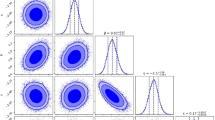Abstract
In this paper we present a statistical description of the cosmological constant in terms of massless bosons (gravitons). To this purpose, we use our recent results implying a non vanishing temperature \({T_{\Lambda }}\) for the cosmological constant. In particular, we found that a non vanishing \(T_{\Lambda }\) allows us to depict the cosmological constant \(\Lambda \) as composed of elementary oscillations of massless bosons of energy \(\hbar \omega \) by means of the Bose–Einstein distribution. In this context, as happens for photons in a medium, the effective phase velocity \(v_g\) of these massless excitations is not given by the speed of light c but it is suppressed by a factor depending on the number of quanta present in the universe at the apparent horizon. We found interesting formulas relating the cosmological constant, the number of quanta N and the mean value \(\overline{\lambda }\) of the wavelength of the gravitons. In this context, we study the possibility to look to the gravitons system so obtained as being very near to be a Bose–Einstein condensate. Finally, an attempt is done to write down the Friedmann flat equations in terms of N and \(\overline{\lambda }\).
Similar content being viewed by others
Notes
As shown in [32], when the Planck constant \(\hbar \) is introduced, a non vanishing \(U_h\) is allowed.
This permit us to trace back [33] the thermal history of the universe in terms of \(T_u-T_h\), being \(T_u\) the temperature of the matter energy inside \(L_h\) where a de Sitter phase emerges when \(T_u=T_h\).
For the case of negative quantum fluctuations, a quantum field theory formalism is necessary [36].
Practically of the same order of the one predicted by the concordance \(\Lambda \)CDM model at present cosmological time.
It is rather natural to suppose that \(\Lambda \), thanks to (8), is thermalized with the apparent horizon.
References
Zlatev, I., Wang, L., Steinhardt, P.J.: Phys. Rev. Lett. 82(5), 896 (1999)
Peebles, P.J.E., Ratra, B.: Rev. Mod. Phys. 75(2), 559 (2003)
Steinhardt, P.J., Turok, N.: Science 312, 1182 (2006)
Hogan, J.: Nature 448(7151), 240 (2007)
Wiltshire, D.L.: Phys. Rev. Lett. 99(25), 251101 (2007)
Caldwell, R.R.: Phys. Lett. B 545, 23 (2002)
Alam, U., Sahni, V., Saini, T.D., Starobinsky, A.A.: Mon. Not. R. Astron. Soc. 344, 1057 (2003)
Chiba, T., Okabe, T., Yamaguchi, M.: Phys. Rev. D 62, 023511 (2000)
Zlatev, I., Wang, L., Steinhardt, P.J.: Phys. Rev. Lett. 82, 896 (1999)
Wetterich, C.: Nucl. Phys. B 302, 302 (1988)
Li, M.: Phys. Lett. B 603, 1 (2004)
Gong, Y.: Phys. Rev. D 70, 064029 (2004)
Gao, C., Wu, F.Q., Cheng, X., Shen, Y.G.: Phys. Rev. D 79, 043511 (2009)
Bhatt, J.R., Desai, B.R., Ma, E., Rajasekaran, G., Sarkar, U.: Phys. Lett B. 687, 75 (2010)
Basilakos, S., Lima, J.A.S., Solá, J.: Int. J. Mod. Phys. D 22, 1342008 (2013)
Das, S., Bhaduri, R.K.: Class. Quantum Gravity 32, 105003 (2015)
Susskind, L.: J. Math. Phys. 36, 6377 (1995)
Jacobson, T.: Phys. Rev. Lett. 75, 1260 (1995)
Corda, C.: Int. J. Mod. Phys. D 18, 2275 (2009)
Abbott, B.P., LIGO Scientific Collaboration and Virgo Collaboration, et al.: Phys. Rev. Lett. 116, 061102 (2016)
Akbar, M., Cai, R.G.: Phys. Rev. D 75, 084003 (2007)
Padmanabhan, T.: Rep. Prog. Phys. 73, 046901 (2010)
Padmanabhan, T.: Gen. Relativ. Gravit. 46, 1673 (2014)
Akbar, M.: Chin. Phys. Lett. 25, 4199 (2008)
Cai, R.G., Kim, S.P.: JHEP 0502, 050 (2005)
Saridakis, E.N., Diaz, P.F.G., Siguenza, C.L.: Class. Quantum Gravity 26, 165003 (2009)
Tian, D.W., Booth, I.: Phys. Rev. D 92, 024001 (2015)
Hayward, S.A.: Phys. Rev. D 49, 6467 (1994)
Faraoni, V.: Phys. Rev. D 84, 024003 (2011)
Viaggiu, S.: Mod. Phys. Lett. A 17, 1450091–1 (2014)
Viaggiu, S.: Gen. Relativ. Gravit. 47(8), 86 (2015). doi:10.1007/s10714-015-1928-y
Viaggiu, S.: Mod. Phys. Lett. A 4, 1650016 (2016)
Viaggiu, S.: Int. J. Mod. Phys. D 2, 1650033 (2016)
Tryon, E.P.: Nature 246, 396 (1973)
Klaers, J., Schmitt, J., Vewinger, F., Veitz, M.: Nature 468, 545 (2010)
Ford, L.H.: Int. J. Mod. Phys. A 25, 2355 (2010)
De Felice, A., Gumrukcuoglu, A.E., Chunshan, L., Mukohyama, S.: Class. Quantum Gravity 30, 184004 (2013)
Bhattacharya, K., Mohanty, S., Nautiyal, A.: Phys. Rev. Lett. 97(25), 251301 (2006)
Author information
Authors and Affiliations
Corresponding author
Rights and permissions
About this article
Cite this article
Viaggiu, S. A statistical representation of the cosmological constant from finite size effects at the apparent horizon. Gen Relativ Gravit 48, 100 (2016). https://doi.org/10.1007/s10714-016-2095-5
Received:
Accepted:
Published:
DOI: https://doi.org/10.1007/s10714-016-2095-5




